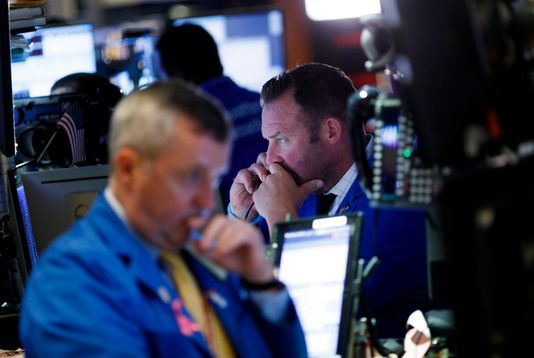
It sure felt like a sell-everything day on Wall Street: Stock prices plunged, and talk of a panic and comeuppance for the nearly 10-year old bull market took hold.
So why did stock prices fall so far, so fast, seemingly out of nowhere? And what explains the 832-point drop for the Dow Jones industrial average just a week after the blue-chip stock gauge notched a record high?
While there’s never a perfect answer to explain how market psychology can turn on a dime, here’s how financial pros are making sense of the worst day for the Dow since February, and a big decline in popular technology stocks.
What sparked the fall?
Nervousness had been building for days on Wall Street. The catalyst was the recent spike in the yield on a closely watched government bond to a seven-year high.
The 10-year Treasury note — whose key rate impacts the pricing on things ranging from fixed-rate mortgages to stocks to virtually every financial asset on the planet — recently climbed above 3.25 percent for the first time since May 2011. And when you add the threat of higher borrowing costs on things like houses and cars and corporate debt to the economic obstacles caused by the U.S. trade war with China, all it takes is a whiff of weakness to set a major sell-off in motion.
“We don’t know who is to blame here; it’s a little like trying to find what or who is responsible for the dangerous hurricane in Florida today,” says Chris Rupkey, chief financial economist at MUFG, a Tokyo-based global bank with offices in New York. “But make no mistake about it, the stock market decline, triggered perhaps by rising bond yields, is just as dangerous.”
Why are interest rates rising?
Rates are heading higher because things are good in the U.S.
“Interest rates are rising because economic data has been positive,” explains Paul Hickey, co-founder at Bespoke Investment Group in New York.
After nearly a decade of historically low interest rates and slow economic growth, the U.S. economy is picking up speed, bolstered by President Trump’s policies such as tax cuts and less regulation of businesses. The economy grew 4.2 percent in the second quarter, its fastest pace in four years. And the job market is robust, with the September unemployment rate of 3.7 percent the lowest in nearly fifty years.
In short, there’s no longer a need for borrowing costs to stay at depressed, emergency levels. The fear now is the economy will get too hot and cause both price and wage inflation to spike, which hurts the buying power of consumers and crimps the earnings of employers.
Why are higher interest rates a problem?
For one, higher interest rates means bonds pay out bigger streams of interest to investors, which makes fixed-income investments a legitimate alternative to stocks. In short, “there’s more competition for stocks,” says Hickey.
Secondly, he says, higher interest rates raise borrowing costs for consumers and companies, so auto loans and mortgages become more expensive and companies have a harder time tapping the debt market. “Clearly, higher rates are not good for housing or auto sales,” says Ed Yardeni, chief investment strategist at Yardeni Research. And if sales of these big-ticket items slow, so does the broader economy.
Finally, higher rates are especially problematic for so-called growth stocks, which includes tech stocks. “The lure for these stocks is growth in earnings down the road, but when interest rates are higher, the future value of those earnings streams declines,” Hickey says.
Why are tech stocks, in particular, dropping?
Shares of tech companies, including the so-called FAANG stocks — Facebook, Apple, Amazon, Netflix and Google-parent Alphabet — have been market darlings for years. So when a sell-off gains steam, the stocks with the biggest gains are among the ones that investors sell first to lock in profits. Tech stocks have also been caught in the trade fight with China, as the Trump’s tough stance on Beijing is causing disruptions in their supply chain. Technology companies like Facebook, Twitter and Alphabet are also facing intense regulatory scrutiny from the U.S. government.
“Tech companies are also in harm’s way because of the trade war with China, in addition to concerns about rising interest rates,” says Chris Zaccarelli, chief investment officer at Independent Advisor Alliance.
Could this be the beginning of a correction?
There’s always a chance that the sell-off can morph into a decline of 10 percent or more from the market’s January peak, which could thrust the market into its second so-called price correction of the year, says Zaccarelli. Still, he predicts that any downturn won’t become a bear market, or 20-percent drop, and will instead turn out to be a good buying opportunity for investors with time to ride out any storm.
Why? “The economic fundamentals are strong and rates are going up for a good reason,” Zaccarelli says.
Is there reason to panic?
“Sure, investors feel nervous, but this is not the time to panic and sell,” advises Thorne Perkin, president of Papamarkou Wellner Asset Management in New York. “We don’t view this as a psychological shift, but an overdue sell-off.”
The current market decline “won’t be fun,” Perkin adds, “but this sell-off will end and a strong economy will carry us through the end of the year.”